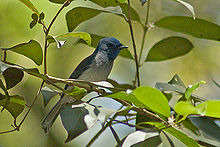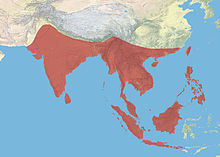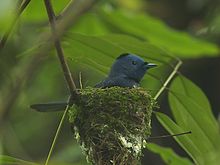- Black-naped Monarch
-
Black-naped Monarch 
A male Black-Naped Monarch flycatcher (ssp. styani) from the Western Ghats of India, Nilgiris district, Tamilnadu state. Conservation status Scientific classification Kingdom: Animalia Phylum: Chordata Class: Aves Order: Passeriformes Family: Monarchidae Genus: Hypothymis Species: H. azurea Binomial name Hypothymis azurea
(Boddaert, 1783)The Approximate Range of the Black-naped Monarch Synonyms Monarcha azurea
The Black-naped Monarch or Black-naped Blue Flycatcher (Hypothymis azurea) is a slim and agile passerine bird belonging to the family of monarch flycatchers. They are sexually dimorphic with males having a distinctive black patch on the back of the head and a narrow black half collar ("necklace") while the female is duller and lacks the black markings. They have a call that is similar to that of the Asian Paradise Flycatcher and in tropical forest habitats pairs may join mixed-species foraging flocks. Populations differ slightly in plumage colour and sizes.
Contents
Description
The adult male Black-naped Monarch is about 16 cm long, and is mainly pale azure blue apart from a whitish lower belly. It has a black nape and a narrow black gorget. The female is duller and lacks the black markings. Her wings and back are grey-brown. There are however several geographically separated breeding populations that differ in the extent and shade of markings. The Indian peninsula (includes sykesi of Stuart Baker[2]) has subspecies styani which has the black markings very distinct. Males of the Sri Lankan race H. a. ceylonensis lack the black nape and gorget and the shade is more purplish. The subspecies of the Andaman Islands, tytleri, has the underparts blue grey. The form on Car Nicobar Island idiochroa has a greyish white belly while nicobarica from the southern Nicobars has a smaller and finer bill.[3][4] The colour of the gape is yellowish to green.[5]
The nominate form is described from the Philippines. A number of other subspecies have been described from Southeast Asia. These include:[6][7][8]
- oberholseri Stresemann, 1913 from Taiwan.
- montana Riley, 1929 & galerita (Deignan, 1956) from Thailand
- forrestia Oberholser, 1911 from the Mergui Archipelago
- prophata Oberholser, 1911 from Peninsular Malaysia, Sumatra and Borneo.
- consobrina Richmond, 1902 from Simeulue Island
- abbotti Richmond, 1902 from Reusam and Babi islands
- leucophila Oberholser, 1911 from Siberut Island
- richmondi Oberholser, 1911 from Enggano Island
- opisthocyanea Oberholser, 1911 from Anamba Island[9]
- gigantoptera Oberholser, 1911 from Bunguran
- karimatensis Chasen & Kloss, 1932 from Karimata Island
- javana Chasen & Kloss, 1929 from Java and Bali.
- penidae Meise, 1941 from Penida Island
- symmixta Stresemann, 1913 from the Lesser Sundas.
- aeria Bangs & J. L. Peters, 1927 from Maratua Island
Some subspecies from the island chains of Southeast Asia, blasii (Banggai Island), catarmanensis (off Mindanao) and puella (Sulawesi), are sometimes treated as the Pale-blue Monarch, Hypothymis puella.[6]
Distribution and habitat
The Black-naped Monarch breeds across tropical southern Asia from India and Sri Lanka east to Indonesia and the Philippines. This species is usually found in thick forests and other well-wooded habitats.
The calls are a sharp and abrupt skrip.[3] The main breeding season in India is in summer from May to July. Two to three eggs are laid in a cup nest placed in the fork of a tree. The nest is decorated with spider egg-cases.[10]
Behaviour and ecology
The Black-naped Monarch has short legs and sits very upright whilst perched prominently, like a shrike. It is insectivorous, often hunting by flycatching. When alarmed or alert, the nape feathers are raised into a pointed crest.[11] They will join mixed-species foraging flocks and are active in the understory of the canopy.[12]
Although they are largely residents, local seasonal movements are known.[13] The breeding season in India is March to August and the nest is neat cup placed in a fork. The nest is built by the female while the male guards. The typical clutch is of three eggs with both parents incubate and feed the young which hatch after about 12 days.[11]
The webs of large spiders such as Nephila maculata have been know to trap the bird.[14]
References
- ^ BirdLife International (2009). Hypothymis azurea. In: IUCN 2008. IUCN Red List of Threatened Species. Downloaded on 8 November 2009.
- ^ Baker, EC Stuart (1923). A hand-list of Genera and Species of Birds of the Indian Empire. Bombay Natural History Society. http://www.archive.org/stream/handlistofgenera00bake#page/80/mode/2up.
- ^ a b Rasmussen, PC & JC Anderton (2005). Birds of South Asia: The Ripley Guide. Volume 2. Smithsonian Institution & Lynx Edicions. p. 333.
- ^ Oates, EW (1890). Fauna of British India. Birds. Volume 2. Taylor and Francis, London. pp. 49–50. http://www.archive.org/stream/faunaofbritishin02oate#page/48/mode/2up.
- ^ Ripley, S. D. (1944). "The Bird Fauna of the West Sumatra Islands". Bulletin of the Museum of Comparative Zoology at Harvard College 94 (8): 307–430. http://www.archive.org/stream/bulletinofmuseum94harv#page/396/mode/2up.
- ^ a b Oberholser, Harry C (1911). "A monograph of the Flycatcher genera Hypothymis and Cyanonympha No. 1803". Proc. U. S Nat. Mus. 39: 585–615. http://www.archive.org/stream/proceedingsofuni391911unit#page/584/mode/2up.
- ^ Rand, AL (1970). "Species formation in the blue monarch flycatchers genus Hypothymis". Nat. Hist. Bull. Siam Soc. 23: 353–365. http://www.thaiscience.info/journals/Article/Species%20formation%20in%20the%20blue%20monarch%20flycatchers%20genus%20hypothymis.pdf.
- ^ Oberholser, Harry C. (1911). "A monograph of the flycatcher genera Hypothymis and Cyanonympha". Proceedings of the United States National Museum 39 (1803): 585–615. http://hdl.handle.net/10088/14242.
- ^ Oberholser, HC (1932). "The Birds of the Natuna Islands". U.S. Nat. Mus. Bull. 159: 1–137. http://www.archive.org/stream/bulletinunitedst1591932unit#page/58/mode/2up.
- ^ Hume, AO (1900). The nests and eggs of Indian birds. Volume 2. R H Porter, London. pp. 27–30. http://www.archive.org/stream/nestseggsofindia02humerich#page/26/mode/2up.
- ^ a b Ali, S & S D Ripley (1996). Handbook of the Birds of India and Pakistan. Volume 7 (2 ed.). New Delhi: Oxford University Press. pp. 223–227.
- ^ Kotagama, SW & Goodale, E (2004). "The composition and spatial organisation of mixedspecies flocks in a Sri Lankan rainforest". Forktail 20: 63–70. http://eben.goodale.googlepages.com/Forktailarticle.pdf.
- ^ Whistler, Hugh (1949). Popular handbook of Indian Birds. 4th edition. Gurney and Jackson. pp. 133–134. http://www.archive.org/stream/popularhandbooko033226mbp#page/n171/mode/2up.
- ^ Andheria,Anish P (1999). "Blacknaped Blue Flycatcher Hypothymis azurea trapped in the web of the Giant Wood Spider Nephila maculata". J. Bombay Nat. Hist. Soc. 96 (1): 145–146.
External links
- Photos and videos
- Hua-Hsiang Chen (2009) A Preliminary Study on Nest Site Selection and Nest Success of the Black-naped Blue Monarch (Hypothymis azurea) in Linnei Township and Douliu hilly area, Yunlin County Thesis Taiwan. (In Chinese)
Categories:- IUCN Red List least concern species
- Hypothymis
- Birds of Asia
Wikimedia Foundation. 2010.



